Corvette E-Ray Delivers Electrified AWD Performance
Estimated Reading Time: 6 MinutesApril 30, 2024
The new 2024 Corvette E-Ray pairs two separate propulsion systems to provide naturally aspirated V8 power with electrified responsiveness powered by eAWD (All-Wheel Drive), delivering all-weather capabilities with impressive performance. (Fig. 1)
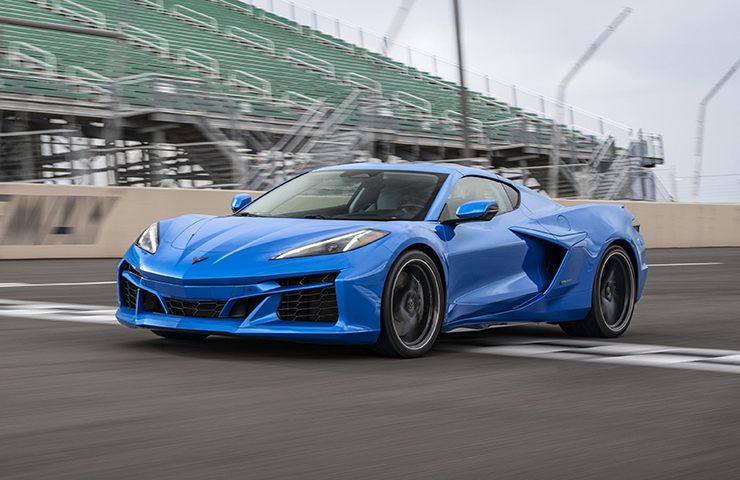
Fig. 1
The 6.2L V8 (RPO LT2) produces 495 horsepower and 470 lb.-ft. of torque. That power is complemented by an electric motor that channels an additional 160 horsepower and 125 lb.-ft. of torque through the front wheels via a 1.9 kWh lithium-ion battery pack, which is located between the seats. (Fig. 2) In total, the E-Ray generates a combined 655 horsepower, making it the quickest production Corvette in history with a 2.5 second 0-60 mph (96 km/h) time.
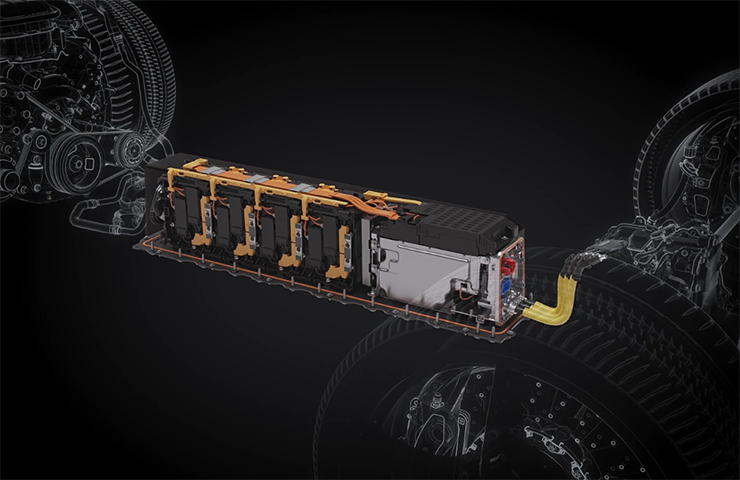
Fig. 2
There is no plug-in charging for the E-Ray’s high-voltage battery system. It’s charged via regenerative energy from coasting and braking, as well as during normal driving.
The A4 Hybrid/Electric Vehicle Battery Pack contains all the components necessary to operate the hybrid system with the exception of the front-drive electric drive unit.
The K16 Battery Energy Control Module (BECM) controls and monitors the high-voltage battery cells. The K107 Drive Motor Control Module, often referred to as the drive motor generator power inverter module, converts high-voltage direct current (DC) electrical energy to 3-phase alternating current (AC) electrical energy. The K107 Drive Motor Control Module operates the T12EF Front Electric Drive Transmission Module. The T12EF drive motor provides motive force to the front wheels.
When the vehicle is operating in an EV mode (Stealth or Shuttle mode), the K1 14V Power Module converts high-voltage direct current (DC) to low-voltage (12V) DC for accessory electrical operation and to charge the 12V lithium-ion battery.
Two cooling systems are utilized for the hybrid/EV components. One system connects to the front of the A4 battery pack and provides thermal management for the power electronic devices. The second system connects to the rear of the A4 battery pack and provides thermal management for the high-voltage battery cells.
Electrified Propulsion
The Corvette E-Ray’s electric drive unit over the front axle is compact, preserving space in the front storage compartment. (Fig. 3) It consists primarily of an 120kW drive motor, a differential carrier, output carrier, automatic transmission fluid pump, automatic transmission scavenging pump, clutch pawl, drive motor disconnect clutch actuator, and one axle shaft. The differential/output gear set provides the fixed forward and reverse ratio. Changing speed and torque is fully automatic and is accomplished through the drive motor generator power inverter control module, located inside the battery pack. The drive motor generator power inverter control module receives and monitors various electronic sensor inputs and uses this information to vary the torque output to the drive axles based on throttle position.
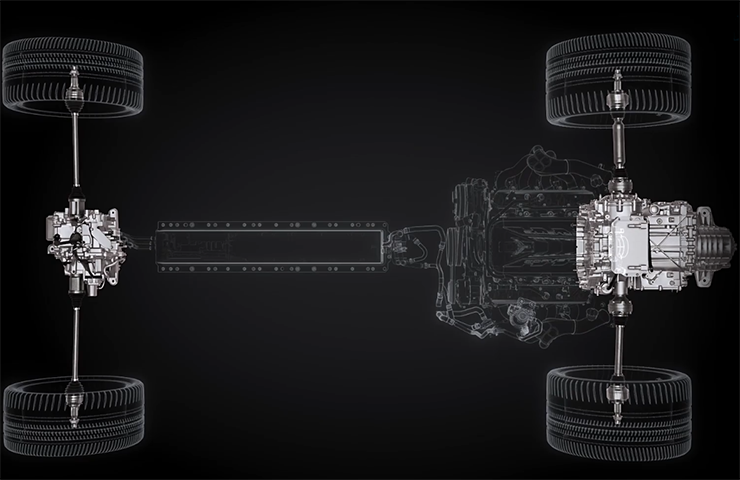
Fig. 3
E-Ray’s standard Active Fuel Management system uses the electric motor to extend 4-cylinder operation in various driving scenarios. The amount of electric assist is tailored within each of the E-Ray’s six driver-selectable modes: Tour, Sport, Track, Weather, My Mode and Z-Mode. Drivers can also select the Charge+ feature to maximize the battery’s state of charge.
The E-Ray Performance App on the infotainment system provides the driver with technical insights into how the propulsion system is operating. (Fig. 4) There are three primary display layouts: Gauges (displays dynamic power output), Dyno (graph of power/torque) and Data (electrical system performance and efficiency).
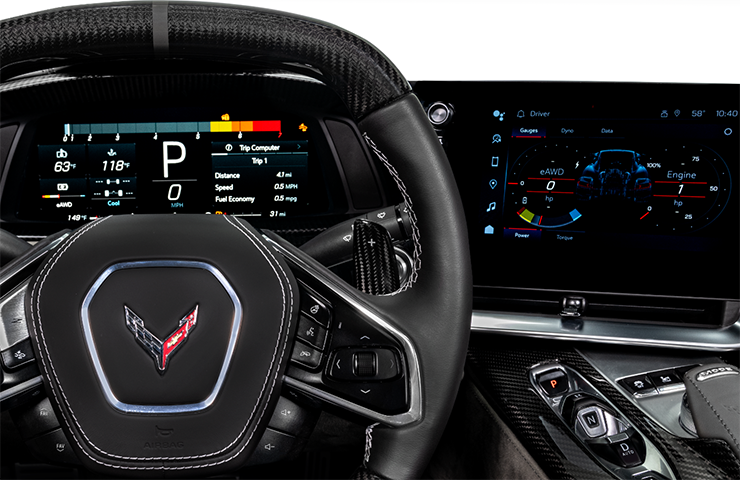
Fig 4.
EV Drive Modes
The Corvette E-Ray’s electrified propulsion system can provide limited all-electric propulsion at the driver’s discretion upon startup. There are two driver-initiated electric modes — Stealth mode and Shuttle mode — that enable the car to travel under electric propulsion in certain conditions. (Fig. 5)
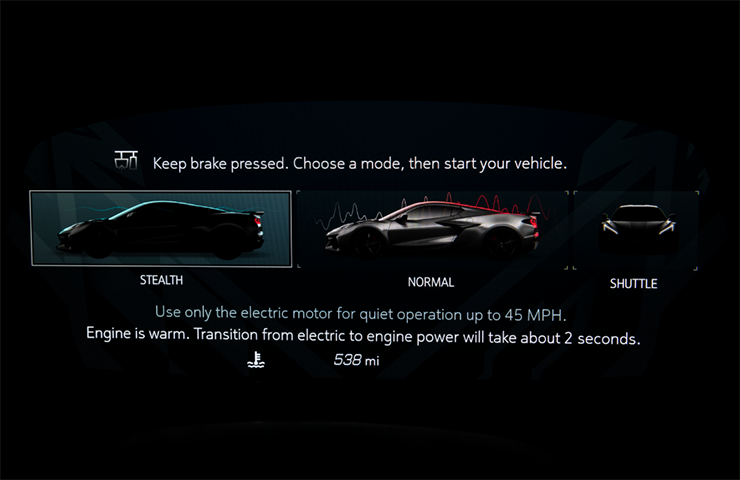
Fig. 5.
Stealth mode enables all-electric driving, when selected at start-up, for a period of time before the engine turns on for normal driving. It is designed for quietly exiting a neighborhood with a maximum speed of 45 mph (72 km/h). The engine automatically engages if the vehicle’s speed exceeds the limit, additional torque is requested by the driver by quickly depressing the accelerator pedal, or the E-Ray’s battery pack is depleted. The Stealth Drive Mode Capability Gauge on the instrument cluster indicates when the engine will start. (Fig. 6) Stealth mode can only be activated once per ignition cycle.
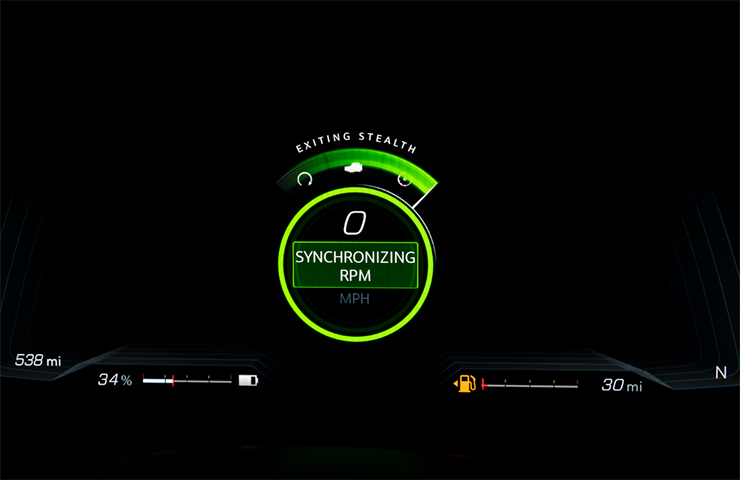
Fig. 6
The following conditions must be met to enable Stealth mode:
- Doors closed, seat belt buckled and brake applied.
- Outside air temperature greater than 50°F (10°C) as determined by the vehicle.
- High-voltage battery greater than 28% displayed state of charge.
- 12v battery greater than 65% state of charge; this parameter is not displayed in the vehicle.
- 12v battery temperature greater than 41°F (5°C); this parameter is not displayed in the vehicle.
- Parked on a grade less than 12%.
- Fuel level greater than 8%.
Shuttle mode provides the ability to propel the vehicle at very low speeds using only electric power. It is not intended for public roads and deactivates if vehicle speed exceeds 15 mph (24 km/h). Only vehicle speed, the battery gauge and electric power gauge are displayed on the instrument cluster.
The following conditions must be met to enable Shuttle mode:
- Doors closed and brake applied.
- Outside air temperature greater than 14°F (-10°C) as determined by the vehicle.
- High-voltage battery greater than 30% displayed state of charge.
- Parked on a grade less than 12%.
TIP: Climate controls are disabled when in an EV drive mode. The engine will start automatically if the climate controls are turned on or if the driver’s seat belt is unbuckled. The heated/ventilated seats and heated steering wheel are enabled in the EV drive modes.
To activate an EV drive mode, the engine must be off.
- Buckle the seat belt and apply the brake pedal.
- Rotate the Driver Mode Control knob on the center console to highlight the Shuttle, Stealth or Normal mode on the instrument cluster.
- Press the Engine Start/Stop button and shift to Drive to enter the selected EV drive mode. An indicator will display on the instrument cluster.
Refer to #PIC6542 for additional information.
Quick Battery Charge
The Charge+ feature can quickly maximize the high-voltage battery state of charge using engine power, which is useful for maximum performance at a track event or to activate Stealth mode. View the Hybrid Battery info tile for state of charge status. Optimal charging occurs at speeds above 35 mph. The Charge+ button is located on the side of the center console. (Fig. 7)
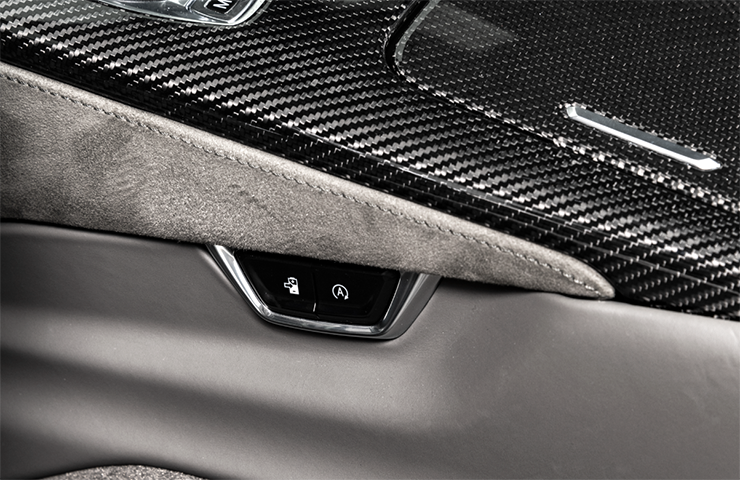
Fig. 7
The Charge+ feature should not be used longer than needed since it draws on engine power to help recharge the battery quickly, rather than charging efficiently through brake or coast regen. When the high-voltage battery is full, no additional regen energy of any type can be captured. When the Charge+ feature is turned off, the high-voltage battery automatically seeks a normal state of charge between 50% – 80%.
Auto Engine Stop/Start
The fuel-saving Engine Stop/Start system automatically turns off the engine, referred to as an Auto Stop, when the brake pedal is applied and the vehicle is at a complete stop, if certain operating conditions are met. When the brake pedal is released or the accelerator pedal is pressed, the engine will restart. Drivers can turn the system on or off by pressing the Auto Stop button on the side of the center console. The button indicator illuminates when the system is on. The system is enabled each time the vehicle is started. The Engine Stop/Start system is not active in manual transmission mode.
For additional information on the Corvette E-Ray, refer to the appropriate Service Information.
– Thanks to Lane Rezek
- Source: GM TechLink